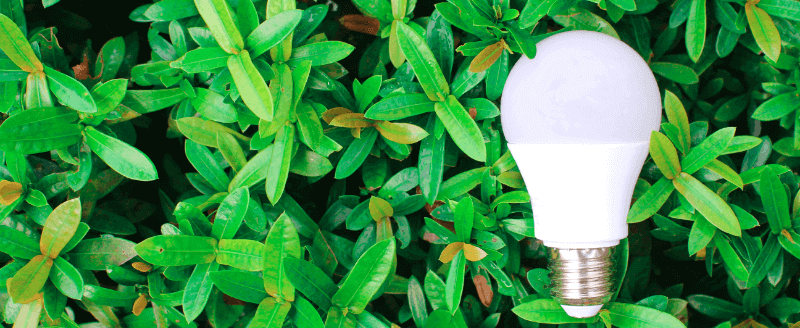How are LED lights better for the environment?
The detrimental effects of climate change and global warming are blatant for all to see, with countries across the world experiencing more extreme and freakish weather events than ever before. Scientific research from the IPCC (the Intergovernmental Panel on Climate Change) has found that current global temperatures are 1.5 C higher than in the period prior to the industrial revolution. So, looking towards sustainable energy solutions is a must.
LED lights are a handy sustainable solution and by more people using them, we can help protect this precious planet we inhabit. But why else should we opt for LED lights over halogen, CFL, and incandescent bulbs? Here we take a deeper look into how are LED lights better for the environment.
LED lights are more energy efficient than traditional lighting
With LEDs, 95% of energy is converted into light and only 5% is wasted as heat. The main reason why LED lights are more energy efficient than ordinary bulbs is that they work using the electrons passing through a semiconductor and don’t have a filament that wears out over time. This helps to explain why LEDs are cooler than standard incandescent bulbs and why they lose less of their energy to heat.

Do you want to do your bit to save the planet? Installing LED bulbs in your home is a pretty straightforward step to reduce your output and maximise your energy efficiency. The benefits of getting LEDs installed at home are two-fold since they should also do a good job of helping to significantly reduce your electricity bills, something we all ought to be striving to do in light of the current rising energy costs.
LED lighting has many other applications outside the home setting. LEDs can also be used for street lights, flood lights, UV-C LED sterilisation in hospitals and healthcare facilities, promoting plant growth, factories and manufacturing centres, motor vehicle headlights, and plenty more.
LED lights have a longer lifespan
LED lights are designed to last considerably longer than traditional bulbs, and this has a positive eco-friendly effect on the environment. So, when you choose to go down the LED lighting route, you won’t have to worry about constantly having to go out and purchase new replacement bulbs thanks to their additional lifespan.
Having to purchase fewer light bulbs will have a positive environmental knock-on effect. Lower demand from consumers for bulbs should result in lower bulb production, ultimately causing fewer ungreen resources to go into things like packaging and product transportation.
LED lights do not contain harmful toxic chemicals
LEDs lights are non-toxic and do not contain hazardous chemicals that can cause harm to the natural environment and human health. On the other hand, fluorescent bulbs contain mercury which is a harmful toxic pollutant when it’s released into the atmosphere. Inhaling mercury can harm the body’s lungs, kidneys, and nervous system.

So, not only are LED lights better for the environment, but business owners and families also don’t have to worry about putting staff or fellow family members at risk from exposure to harmful chemicals when installing LEDs. The fact that LED lights are eco-friendly and without toxic chemicals is one of the reasons why there is a mass move towards using them across the board.
LEDs have a much smaller carbon footprint
The total amount of carbon dioxide released into the atmosphere as a result of human activities is called a carbon footprint. LEDs contain vastly lower quantities of greenhouse gas emissions than traditional incandescent or fluorescent light bulbs. So, businesses, organisations, and individuals can all reduce their carbon footprint by using LED lights.
We can all do more to lead a more sustainable lifestyle and chip in to help combat climate change. Recycling as much as you can plays a big role in reducing your carbon footprint. LED bulbs are 100% recyclable, so they don’t end up rotting away in a landfill site!
LED lights help promote plant growth
Biologists and plant experts firmly agree that LED lighting is an ideal artificial lighting solution for promoting plant growth. Plants prefer blue and red grow lights to reach their full growth potential and fortunately you can get LED lights in a range of colours, not just white.

Indoor plants and gardens are en vogue these days, especially since many people spent the lockdowns during the pandemic working remotely from homes without access to a sizeable outdoor garden space. Indoor plants need all the quality artificial light they can get since they have limited access to light compared to if they were outdoors and taking in natural sunlight.
LED lights lose less heat to the environment
LED lights lose a really minimal level of heat to the environment compared with other types of lights. This is due to the fact that they have such a high light conversion efficacy. Incandescent bulbs with wired filaments give off the most heat given that they are the least energy efficient.
In contrast, LED lights are able to stay relatively cool to touch and therefore are more energy efficient. This is why LEDs are able to last 25 times longer than traditional bulbs, amounting to a lifetime of more than 3 years if they run for 24 hours a day, seven days a week. All of this means that they are around 6 to 7 times more energy efficient than conventional incandescent bulbs, cutting energy use by up to 80%.
Hopefully, you now understand much more about LED lights and how they are much better for the environment than other light sources. To get your hands on some LED light fittings from a leading brand, get in touch with us at INUI by sending an email to sales@inui.co.uk or calling us on 01509 266355.